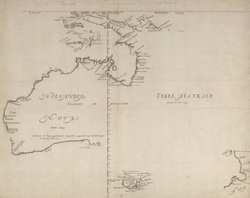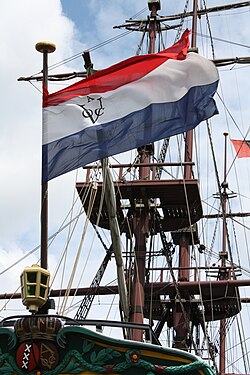
New Holland (Dutch : Het Niew Holland or Nieuw-Holland) is a historical European name for mainland Australia, first encountered by Europeans in 1606, by Dutch navigator Willem Janszoon aboard Duyfken. The name was first applied to Australia in 1644 by the Dutch seafarer Abel Tasman, and for a time came to be applied in most European maps to the vaunted "Southern land" or Terra Australis even after its coastline was finally explored.
Contents
- History
- Dutch exploration and discovery (c. 1590s–1720s)
- British colonisation
- French exploration
- Change of name
- In literature
- Description
- Other literature
- See also
- References
The continent of Antarctica, later named in the 1890s, was still in largely speculative form; it resumed the name Terra Australis (sometimes suffixed Non Cognita, lit. 'unknown'). Its existence had been speculated on in some maps since the 5th century, under the theory of "balancing hemispheres".
Lieutenant James Cook, during his first voyage of discovery, claimed the eastern portion of the Australian continent for the British Crown in 1770, naming it New South Wales. The British settlement of Sydney as a colony in 1788 prompted Britain to formally claim the east coast as New South Wales, leading to a search for a new collective name. New Holland was never settled by the Dutch people, whose colonial forces and buoyant population had a settled preference for the Dutch Cape Colony, Dutch Guyana, the Dutch East Indies, Dutch Ceylon and the Dutch West Indies.
New Holland continued to be used semi-officially and in popular usage as the name for the whole land mass until at least the mid-1850s.




